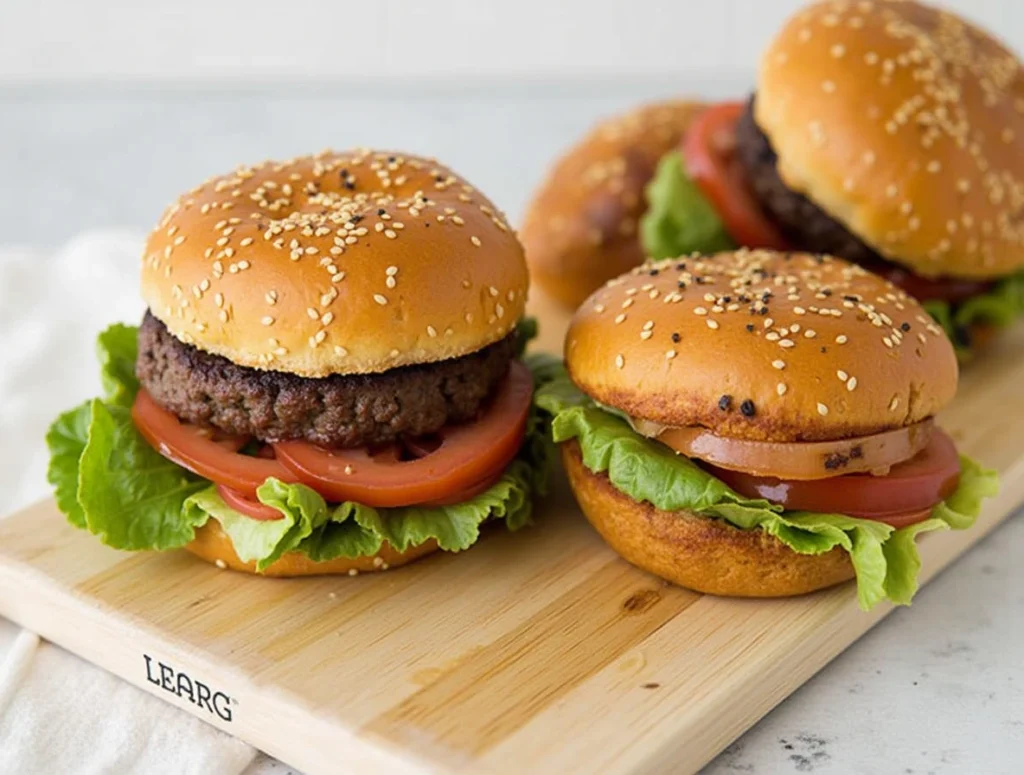
What Makes Sourdough Hamburger Buns Better? The Ultimate Guide
As a chef with nearly three decades of experience crafting the perfect burger, I’ve learned that the path to burger nirvana begins not with the patty but with the humble bun. And when it comes to elevating your burger experience, nothing quite compares to the tangy complexity and artisanal texture of sourdough hamburger buns.
The difference between a good burger and a transformative one often comes down to this foundation. While commercial buns serve their purpose, homemade sourdough buns bring layers of flavor, superior structure, and nutritional benefits that can revolutionize your burger game forever.
In this comprehensive guide, I’ll walk you through everything you need to know about sourdough hamburger buns – from their distinctive advantages over conventional buns to a foolproof recipe that will have you baking like a pro. Whether you’re a dedicated home baker or a burger enthusiast looking to take your creations to the next level, you’re in the right place.
Discover why sourdough buns are worth the extra effort and how they can transform an ordinary burger into an extraordinary culinary experience.
The Science Behind Sourdough’s Superior Flavor
The magic of sourdough begins with its fundamental difference from commercial yeasted bread—the fermentation process. Unlike conventional burger buns, which rely on commercial yeast for a quick rise, sourdough harnesses the power of wild yeast and beneficial bacteria that develop naturally over time.
This natural fermentation process creates lactic and acetic acids that give sourdough its distinctive tangy flavor profile. The longer fermentation time (typically 8-24 hours) allows for the development of complex flavor compounds that cannot be replicated in quickly-produced commercial buns.
The science is fascinating: during fermentation, amylase enzymes break down complex starches into simple sugars, which the wild yeast and bacteria consume. This process creates the characteristic sourdough flavor and produces carbon dioxide, giving the bread its rise and distinctive texture.
Dr. Michael Gänzle, a food microbiologist at the University of Alberta, explains that “the diverse microbial community in sourdough starters produces a wider range of flavor compounds than commercial yeast alone can generate.” These include organic acids, alcohols, esters, and other aromatic compounds contributing to sourdough’s complex taste profile.
When you bite into a burger with a sourdough bun, your palate experiences layers of flavor – nutty, tangy, slightly sweet, with earthy undertones – that perfectly complement the savory richness of a well-seasoned beef patty. This flavor synergy makes sourdough hamburger buns the secret weapon of many top-rated establishments.
How Fermentation Enhances Texture and Structure
Beyond flavor, the extended fermentation period of sourdough contributes significantly to superior texture and structure. During this time, gluten proteins undergo changes that create a more complex protein network than conventional quick-rise buns.
The result is a bun with:
- A sturdy yet tender crumb that holds up to juicy patties without disintegrating
- A satisfying chew that adds textural contrast to your burger
- A caramelized, slightly crisp crust that brings another dimension to each bite
- Better resistance to becoming soggy when faced with burger juices and condiments
This structural superiority makes sourdough buns particularly well-suited for gourmet burgers with multiple toppings and sauces—they maintain their integrity from the first bite to the last.
Nutritional Benefits of Sourdough vs. Regular Hamburger Buns
The advantages of sourdough hamburger buns extend far beyond taste and texture – they offer significant nutritional benefits compared to their conventional counterparts.
Improved Digestibility
The long fermentation process of sourdough breaks down proteins, particularly gluten, making it easier for many people to digest. While not suitable for those with celiac disease, some individuals with mild gluten sensitivity report being able to enjoy sourdough without discomfort.
This digestibility improvement occurs because the lactic acid bacteria in sourdough partially degrade gluten proteins during fermentation. Additionally, they neutralize phytic acid, an anti-nutrient that can interfere with mineral absorption in the digestive tract.
Enhanced Nutrient Availability
Sourdough fermentation increases the bioavailability of essential nutrients in the flour through several mechanisms:
- Mineral availability: Reducing phytic acid means minerals like iron, zinc, and magnesium become more bioavailable.
- Prebiotic properties: Fermentation creates prebiotic compounds that support gut health and beneficial gut bacteria.
- Lower glycemic index: Studies suggest that sourdough bread produces a lower insulin response than conventional bread, making it a better option for blood sugar management.
Research published in the Journal of Cereal Science indicates that “sourdough fermentation can increase the amount of folate in bread by about 3-4 times compared to non-fermented bread.” This B vitamin is essential for cell growth and metabolism.
For health-conscious burger enthusiasts, switching to sourdough buns represents a simple upgrade that adds nutritional value without sacrificing enjoyment. Many find the complex flavor profile enhances their overall burger experience.
Essential Ingredients for Perfect Sourdough Hamburger Buns
Creating exceptional sourdough hamburger buns begins with understanding the key ingredients and their roles. Sourdough’s beauty lies in its simplicity—you need just a few basic ingredients. Still, their quality and proper handling make all the difference.
The Sourdough Starter: Your Secret Weapon
At the heart of every sourdough bun is a healthy, active starter. This living culture of wild yeast and beneficial bacteria is the leavening agent and flavor foundation.
For the best sourdough hamburger buns, you’ll want:
- Active starter: Feed your starter 8-12 hours before making your dough to ensure it’s at peak activity
- Mature flavor: A starter that’s at least a few weeks old will provide better flavor complexity
- Consistency: A 100% hydration starter (equal parts flour and water by weight) works best for most recipes
Don’t have a starter yet? Creating your own is surprisingly simple – combine equal parts flour and water, then “feed” it daily by discarding half and adding fresh flour and water. Within 7-10 days, you’ll have a vibrant, bubbly starter ready for baking. Alternatively, ask a friend for some of their established starters or purchase one online from reputable sources.
Flour Selection: Building the Foundation
The flour you choose significantly impacts your buns’ texture, flavor, and nutritional profile:
- Bread flour: With its higher protein content (typically 12-14%), bread flour provides the necessary gluten development for structure and chew. This is my top recommendation for beginners.
- All-purpose flour: Works well, especially when combined with some bread flour, for a slightly lighter texture.
- Whole wheat additions: Replacing 15-30% of the white flour with whole wheat adds nuttiness and nutritional value. My favorite is a 70% bread flour blend and 30% freshly milled whole wheat.
- Ancient grain additions: Small amounts of spelled, einkorn, or rye flour (5-15% of total flour weight) can introduce complexity and depth of flavor.
Consider investing in freshly milled flour containing all the grain’s natural oils and flavor compounds for truly exceptional buns. As James Beard Award-winning baker Chad Robertson notes, “Freshly milled flour is to bread what freshly ground coffee is to your morning brew – an entirely different experience.”
Hydration: Finding the Sweet Spot
Sourdough hamburger buns benefit from moderate hydration – typically 65-70% (meaning water weight is 65-70% of the flour weight). This creates a dough that’s:
- Easy enough to handle and shape
- Moist sufficient for a tender crumb
- Structured enough to hold up to burger toppings
For easier handling, beginners should start at the lower end of this range (65%). At the same time, experienced bakers might experiment with higher hydration for an airier texture.
Enrichments: Creating the Perfect Burger Vehicle
Unlike artisan sourdough loaves that often contain just flour, water, and salt, hamburger buns benefit from enrichments that create a softer, more tender product:
- Butter: Adds richness and tenderness (4-8% of flour weight)
- Eggs: Provide structure, color, and richness
- Milk: Creates a softer crumb and encourages browning
- Honey or sugar: Adds slight sweetness, encourages browning, and feeds the yeast for better rise (2-4% of flour weight)
These enrichments transform the classic sourdough formula into something specifically designed for the perfect burger experience – sturdy enough to hold toppings yet tender enough to bite through easily.
Foolproof Easy Sourdough Hamburger Buns Recipe
Now that we understand the science and ingredients let’s combine it with my tried-and-true recipe for spectacular sourdough hamburger buns. This recipe has been refined over years of professional and home baking, striking the perfect balance between simplicity and exceptional results.
Ingredients
For eight medium-sized hamburger buns:
Ingredients
100g active sourdough starter (100% hydration)
500g bread flour
300g whole milk, slightly warmed
50g butter, softened
1 large egg
25g honey or sugar
10g salt
Sesame seeds for topping (optional)
1 egg beaten with one tablespoon of water for egg wash
Equipment
- Stand mixer with dough hook (optional but helpful)
- Digital kitchen scale
- Large mixing bowl
- Bench scraper
- Baking sheet
- Parchment paper
Step-by-Step Instructions
Day 1: Prepare the Dough (Evening)
- Feed your starter: 8-12 hours before making your dough, feed your starter so it’s active and bubbly when you’re ready to begin.
- Mix the dough: In a large bowl or stand mixer, combine the active starter, warmed milk, egg, and honey. Mix until well combined.
- Add dry ingredients: Mix the flour until no dry flour remains. Cover and let rest for 30 minutes (this autolyze period allows the flour to hydrate fully).
- Add salt and butter: After rest, add salt and softened butter. Knead by hand for 8-10 minutes or with a stand mixer for 5-6 minutes until the dough becomes smooth and elastic.
- Bulk fermentation: Place the dough in a lightly oiled bowl, cover, and let ferment at room temperature (68-72°F/20-22°C) for 2-3 hours until noticeably puffy but not necessarily doubled.
- Cold retard: Transfer the covered bowl to the refrigerator and let it rest overnight (8-12 hours). This slow fermentation develops flavor and makes the dough easier to handle.
Day 2: Shape and Bake (Morning)
- Divide and pre-shape: Remove the dough from the refrigerator. On a lightly floured surface, divide it into eight equal pieces (about 120-125g each). Gently form each piece into a rough ball and let rest, covered, for 15 minutes.
- Final shaping: With lightly floured hands, shape each piece into a tight ball by folding the edges toward the center and then rolling between your palm and the countertop to create tension on the surface.
- Arrange and proof: Place the shaped buns on a parchment-lined baking sheet, leaving 2-3 inches between each. Lightly cover with oiled plastic wrap and letproof at room temperature for 3-4 hours until noticeably puffy.
- Preheat: 45 minutes before baking, preheat your oven to 375°F (190°C).
- Final touch: Gently brush the proofed buns with egg wash and sprinkle with sesame seeds if desired.
- Bake: Bake for 18-22 minutes until golden brown and the internal temperature reaches 190°F (88°C).
- Cool: Transfer to a wire rack and cool completely before slicing.
Pro Tips for Perfect Results
- Temperature matters: Dough temperature affects fermentation rate. In summer, use cooler liquid; in winter, slightly warmer.
- The poke test: To check if buns are properly proofed, gently poke with a floured finger. The dough should spring back slowly, leaving a slight indentation.
- Steam for better crust: For the first 5 minutes of baking, spray the oven walls with water or place a tray of ice cubes on the bottom rack to create steam.
- Butter the tops: For a softer crust, brush the hot buns with melted butter immediately after baking.
As with all sourdough baking, patience is key. The extra time invested yields hamburger buns with unparalleled flavor and texture, elevating even the simplest burger to gourmet status.
Overnight Sourdough Buns: A Time-Saving Variation
For busy home cooks, this overnight variation streamlines the process while maintaining quality:
Modified Timeline
Evening (Day 1):
- Prepare the dough as instructed above
- After kneading, place directly in an oiled bowl
- Cover and refrigerate immediately for 12-16 hours
Morning (Day 2):
- Remove dough from refrigerator
- Divide, shape, and place on a baking sheet
- Let proof at room temperature for 4-6 hours (they’ll need longer coming from cold)
- Bake as directed
This variation fits easily into a busy schedule while still delivering excellent results. Extended cold fermentation enhances flavor development, creating a more complex taste profile.
Troubleshooting Common Sourdough Bun Issues
Even experienced bakers encounter challenges. Here’s how to address common problems:
Dense or Heavy Buns
Possible causes:
- Underproofed dough
- Inactive starter
- Too much flour during shaping
Solutions:
- Ensure your starter is actively bubbling before use
- Allow for adequate proofing time (the buns should be visibly puffy)
- Handle the dough gently to preserve air bubbles
- Be mindful of flour addition during shaping
Flat Buns with No Rise
Possible causes:
- Overproofed dough
- Weak gluten development
- Low-protein flour
Solutions:
- Oversee proofing time, especially in warm weather
- Develop gluten adequately during mixing/kneading
- Use bread flour with higher protein content (12-14%)
- Consider the “float test” for your starter – a spoonful should float in water when ready
Inconsistent Sizes
Possible causes:
- Uneven division of dough
- Irregular shaping technique
Solutions:
- Use a scale to weigh each portion for perfect uniformity
- Practice consistent shaping technique
- Use ring molds if necessary for professional results
Creative Variations for Gourmet Sourdough Hamburger Buns
Once you’ve mastered the basic recipe, consider these creative variations to match specific burger styles:
Whole Grain Rustic Buns
Replace 30-40% of the bread flour with whole wheat, spelled, or rye flour for a heartier, more nutritious option that pairs beautifully with grass-fed beef burgers. Add one tablespoon of vital wheat gluten to maintain proper structure.
Herb and Garlic Buns
During the initial mix, add two tablespoons of finely chopped fresh herbs (rosemary, thyme, or chives) and two minced garlic cloves to the dough. These buns pair exceptionally well with Italian cheeseburgers.
Onion Buns
Mix 1/4 cup of caramelized onions into the dough and sprinkle the tops with dried flakes before baking. The subtle sweetness and depth complement burgers with bold flavors like blue cheese or mushroom toppings.
Cheese-Crusted Buns
Sprinkle the tops with grated Parmesan, Asiago, or cheddar before baking for a crispy, savory crust that adds another dimension to your homemade cheeseburger.
Multi-Seed Artisan Buns
Add three tablespoons of mixed seeds (sunflower, pumpkin, flax, poppy) to the dough and sprinkle more before baking. These nutrient-dense buns work beautifully with turkey or veggie burgers.
Storing and Freezing Sourdough Hamburger Buns
Sourdough buns stay fresh longer than conventional ones due to their natural acidity, but proper Storage maximizes their quality:
Short-Term Storage (1-2 days)
Store cooled baked buns in a bread bag or airtight container at room temperature. Avoid refrigeration, which accelerates staling through a process called retrogradation.
Freezing for Later Use (Up to 3 months)
- Cool buns completely
- Wrap individually in plastic wrap or aluminum foil
- Place wrapped buns in a freezer bag, removing as much air as possible
- Label with the date
- Freeze for up to 3 months
Refreshing Stored Buns
For room-temperature buns, lightly toast the cut sides in a skillet or under the broiler for 1-2 minutes.
For frozen buns:
- Thaw at room temperature for 1-2 hours
- Refresh in a 300°F (150°C) oven for 5-7 minutes
- Alternatively, toast from frozen by slicing and placing directly in a toaster or under the broiler
This refreshing step is crucial for the ultimate burger experience, as it revitalizes the texture and intensifies the flavor of the buns.
Building the Ultimate Burger with Sourdough Buns
Now that you’ve created the perfect sourdough buns let’s talk about building a burger worthy of this artisanal foundation. Sourdough’s unique characteristics demand thoughtful pairing with complementary ingredients.
Ideal Burger-to-Bun Ratio
The perfect ratio is approximately 1:1 between patty and bun thickness. Since sourdough buns have more substance and flavor than commercial alternatives, they can withstand a more substantial patty—ideally 6-7 ounces of meat for a standard-sized bun.
Patty Styles That Shine with Sourdough
Classic beef blend: A mix of chuck, brisket, and short rib (80/20 fat content) provides the perfect balance of flavor and juiciness to complement sourdough’s tangy profile.
Lamb burgers: The distinctive flavor of lamb pairs beautifully with the subtle sourness of the bun, especially when seasoned with Mediterranean herbs.
Mushroom-beef blend: Replace 25-30% of the meat with finely chopped, sautéed mushrooms for an umami-rich patty that enhances the fermented notes in the sourdough.
For inspiration, check out these top Italian burger recipes that pair wonderfully with sourdough buns.
Condiment Considerations
The robust nature of sourdough buns pairs well with bold condiments:
- Aioli or herb mayo: The creaminess balances the tang of the sourdough
- Whole grain mustard: The texture and pungency complement the bun’s complex flavor
- Tomato jam: Sweet-acidic notes create a perfect counterpoint to the bread
- Caramelized onions: Their sweetness balances the slight acidity of the bun
Building for Structural Integrity
Sourdough’s sturdy structure allows for thoughtful layering without collapse:
- Bottom bun: Apply a thin layer of fat (mayo or butter) to create a moisture barrier
- Lettuce or greens: Place immediately on the barrier to further protect from juices
- Patty and cheese: Position in the middle of the stack
- Wet toppings: Tomatoes, pickles, and sauces go toward the top
- Top bun: Lightly toast the cut side for maximum stability
For the whole burger experience, pair your creation with this delicious hamburger potato soup for a complete meal.
The Environmental Impact of Sourdough Baking
Beyond flavor and nutrition, choosing homemade sourdough buns represents a more sustainable approach to burger making:
Reduced Food Waste
Commercial bread products account for a significant portion of food waste. By making your sourdough buns:
- You can produce exactly what you need
- Stale buns can be repurposed into breadcrumbs, croutons, or bread pudding
- Discard from feeding your starter can be used in pancakes, crackers, or pizza crust
Lower Carbon Footprint
Homemade sourdough typically has a lower carbon footprint than commercially produced bread for several reasons:
- No industrial processing or preservatives
- Reduced packaging waste
- No transportation emissions from the factory to the store
- More efficient energy use (baking multiple items when the oven is hot)
Supporting Local Grain Economies
When sourcing flour for your sourdough buns, seek local or regional flour producers:
- Supports small-scale agriculture
- Preserves grain diversity through heritage variety cultivation
- Reduces transportation emissions
- Promotes food sovereignty and security
The Sustainable Food Trust noted, “Sourcing locally milled flour from regional grain farmers creates resilient food systems while producing bread with superior flavor and nutrition.”
How Sourdough Hamburger Buns Compare to Fast Food Options
To fully appreciate the superiority of homemade sourdough buns, let’s compare them to typical fast food options:
| Characteristic | Sourdough Hamburger Buns | Typical Fast Food Buns |
| Ingredients | 5-7 simple ingredients | 15-20+ ingredients including preservatives, dough conditioners, and high-fructose corn syrup |
| Fermentation time | 12-24 hours | 1-2 hours |
| Flavor profile | Complex, tangy, nutty | Mild, sweet, uniform |
| Texture | Chewy crust, tender interior with irregular air pockets | Soft, uniform, often gummy when compressed |
| Shelf life (unpreserved) | 3-4 days | 1-2 days |
| Nutritional profile | Higher protein availability, prebiotics from fermentation, lower glycemic index | Higher simple carbohydrates, minimal nutritional benefits |
| Digestibility | Enhanced through fermentation | Often causes bloating due to quick fermentation |
The stark contrast explains why more American fast-food establishments are beginning to offer sourdough options as premium alternatives for discerning customers.
While fast food chains optimize for consistency and speed, homemade sourdough optimizes for flavor, nutrition, and the overall eating experience. The difference becomes immediately apparent with the first bite of a burger made with a quality sourdough bun.
For those curious about the nutritional impact of their burger choices, our calorie calculator can help you compare different burger builds.
Cost Analysis: Are Homemade Sourdough Buns Worth It?
Let’s break down the economics of making your sourdough hamburger buns compared to store-bought alternatives:
Cost Comparison
| Item | Homemade Sourdough Buns (8 buns) | Premium Store-Bought Buns (8 buns) | Basic Store-Bought Buns (8 buns) |
| Flour | $1.20 | – | – |
| Milk | $0.60 | – | – |
| Butter | $0.50 | – | – |
| Eggs | $0.25 | – | – |
| Honey/Sugar | $0.15 | – | – |
| Salt | $0.05 | – | – |
| Electricity/Gas | $0.25 | – | – |
| Total Cost | $3.00 ($0.38 per bun) | $5.99 ($0.75 per bun) | $2.79 ($0.35 per bun) |
The True Value Proposition
While bare store-bought buns might appear slightly cheaper, the value equation shifts dramatically when considering:
- Quality differential: The taste, texture, and nutritional benefits of sourdough far exceed even premium store options
- Customization options: Homemade allows adaptation for dietary needs or flavor preferences
- Skill development: Learning to bake builds valuable culinary skills
- Satisfaction factor: The pride and pleasure of serving something made from scratch
As food writer Michael Pollan notes, “Cooking [and baking] is one of the most valuable skills you can develop. It’s far more economical than buying prepared foods, infinitely more satisfying, and, with practice, not necessarily more time-consuming.”
For burger enthusiasts looking to create exceptional classic cheeseburgers with melted cheese drip, the modest investment in homemade sourdough buns pays tremendous dividends in eating pleasure.
Comparing Sourdough Buns Across Different Cuisines
Sourdough principles appear in burger buns across various food traditions, each offering unique perspectives we can incorporate:
American Artisanal Approach
The American craft bakery movement emphasizes:
- Open, irregular crumb structure
- Pronounced tang from higher acidity
- Distinctive scoring patterns
- Often incorporates potato for tenderness
These elements have influenced top American foods, including gourmet burgers.
European Traditions
German: Incorporating partial rye flour for a hearty flavor that pairs beautifully with robust toppings like those found in Italian cheeseburger vs traditional burger comparisons.
French: Emphasizing technique and precise temperature control for optimal rise and texture.
Mediterranean: Add olive oil to the dough for tenderness and incorporate herbs like rosemary or oregano.
Fusion Approaches
Modern bakers are creating innovative sourdough bun variations by incorporating:
- Japanese milk bread techniques (tangzhong) for exceptional softness
- Middle Eastern flavors like za’atar or sumac in the dough
- Mexican influences with the addition of corn flour and mild chilis
These cross-cultural techniques demonstrate sourdough’s remarkable versatility as a foundation for burger buns across culinary traditions.
Quick Takeaways: The Sourdough Advantage
After exploring sourdough hamburger buns in-depth, here are the key insights:
- Superior flavor profile: The long fermentation develops complex, tangy notes that enhance the entire burger experience
- Structural integrity: Sourdough buns hold up better to juicy patties and sauces without becoming soggy
- Nutritional benefits: Enhanced digestibility, nutrient availability, and potentially lower glycemic impact compared to regular buns
- Preservation qualities: Natural acids extend shelf life without artificial preservatives
- Customization potential: The basic sourdough technique can be adapted with different flours, seeds, and flavors to complement specific burger styles
- Sustainability advantage: Homemade sourdough represents a more environmentally conscious choice with less waste and packaging
- Cost-effectiveness: Despite requiring more time, homemade sourdough buns are economical compared to premium store-bought alternatives
Conclusion: Elevating Your Burger Experience
The journey to burger perfection is paved with countless decisions – the meat blend, cooking method, toppings, and sauces play crucial roles. Yet the foundation of this culinary masterpiece – the humble bun – too often receives insufficient attention.
Sourdough hamburger buns represent the pinnacle of what a burger vessel can be. Their complex flavor, superior structure, and enhanced nutritional profile transform the eating experience. The difference is immediately apparent – that first bite through the slightly crisp exterior into the tender, flavorful crumb sets the stage for burger nirvana.
While they require more time and attention than picking up a package at the supermarket, sourdough buns repay your investment often in eating pleasure. The techniques outlined in this guide put exceptional results within reach of home bakers at any skill level.
I encourage you to embrace the sourdough difference for your next burger night. Start your starter, mix that first batch of dough, and experience how this ancient bread-making technique can revolutionize a modern favorite. Your taste buds – and your dinner guests – will thank you.
And remember, in a world where convenience often trumps quality, taking the time to create something exceptional is an act of culinary rebellion worth celebrating. Happy baking and even happier burger-making!
Frequently Asked Questions
Can I make sourdough hamburger buns without a starter?
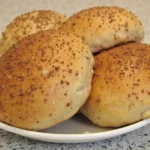
No, the defining characteristic of true sourdough is fermentation using a natural starter culture. However, you can create a starter from scratch using flour and water in 7-10 days. Alternatively, “quick sourdough” methods using yogurt or buttermilk can approximate tangy flavor notes. Still, they won’t provide the same benefits or authentic taste.
How long do homemade sourdough hamburger buns stay fresh?
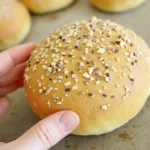
When properly stored in an airtight container at room temperature, homemade sourdough buns typically stay fresh for 3-4 days – significantly longer than conventional homemade buns. For extended Storage, freeze for up to 3 months and refresh in a warm oven before serving.
Can I make sourdough hamburger buns with gluten-free flour?
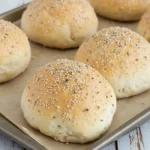
Yes, but it requires significant recipe modification. Gluten-free sourdough needs additional binding agents (like psyllium husk or xanthan gum). It performs best with a blend of gluten-free flour rather than a single type. Results won’t be identical to wheat-based sourdough, but it can still be delicious with the proper technique.
What’s the minimum time needed to make sourdough hamburger buns?
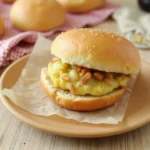
Using the overnight method and an active starter, you need approximately 24 hours from start to finish. While this is significantly longer than conventional buns, most is passive fermentation time rather than active work. The hands-on time is typically only 30-40 minutes, spread across the process.
How do I know when my sourdough hamburger buns are properly proofed?
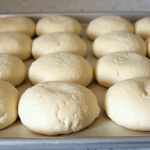
Properly proofed sourdough buns should be noticeably puffy but not double in size. The poke test is reliable: gently poke the dough with a floured finger about 1/2 inch deep—the indentation should slowly spring back but not completely disappear. Overproofed buns will collapse when poked, while underproofed buns will spring back completely and quickly.
About the Author: Chef HAMZA has been perfecting burger recipes for over 28 years. His passion for exceptional ingredients and techniques has made him a trusted voice in the culinary world. Through his blog, TheFoodNearMe, he shares his expertise and love for transformative food experiences with home cooks and food enthusiasts worldwide.
Have you tried making sourdough hamburger buns? Share your experience in the comments below! If you find this guide helpful, please share it with your fellow burger enthusiasts on social media.
